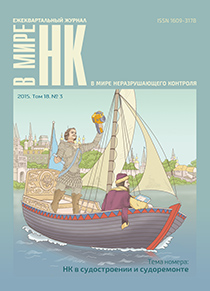Moskva, Moscow, Russian Federation
Introduction. Nowadays ship hull diagnostics is carried out in dry-dock or using divers in the road. The both technologies are time consuming, labour and material resource demanding. Specialists from Bauman Moscow State Technical University have developed a diagnostics system that allows the ship hull underwater part inspection to be performed without calling at dry-dock and without divers. The system includes the following main elements: remotely operated vehicle that contains diagnostics tools; hydro acoustic navigation system; software; and diagnostics technology. Method. The technology is based on an acoustic method of non-destructive testing (NDT). SH-waves with elastic vibrations excitation by non-contact method are used without necessity of thorough surface preparation before testing. SH-waves are also used for flaw detection within damaged areas (areas of different thicknesses). As the research has shown, the mirror-shadow technique with bottom signal attenuation as a criterion for corrosion crack detection is most effective. The minimum detectable deep of the corrosion cracks is 1.5–2 mm. The proposed diagnostics technology uses electromagnetic acoustic transducers (EMAT) with a 5 MHz frequency. Results. The diagnostics system was successfully tested in the pool. The test results confirmed the system’s ability to perform automatic metal diagnostics with wall thickness measurements and defect detection within areas of corrosion. Discussions. Nowadays the system is under the process of Russian Maritime Register of Shipping approval. It is planned to develop a system with arc welding tools for underwater objects repair. Prospects of diagnostics system usage for the various underwater steel structures including ones located on the Russian Federation Arctic shelf are under consideration.
thickness measurement, technical condition, ships, monitoring system, remotely operated underwater vehicles, deterioration, corrosion, flaw detection
1. Goryunov N.S. Osobennosti tekhnicheskoy ekspluatatsii flota rybnoy promyshlennosti [Special aspects of fleet technical maintenance in the fishing industry]. Moscow, Pishchevaya promyshlennost´ Publ., 1975, 310 p. (in Russ.).
2. Fostiy G. P. Sudokorpusnik-remontnik [Repairer of ship hulls]. Leningrad, Sudostroenie Publ., 1986, 304 p. (in Russ.).
3. Popov Yu. N., Faddeev O. V., Kheysin D. E., Yakovlev A. Ya. Prochnost´ sudov, plavayushchikh vo l´dakh [Strength of the ships sailing in polar waters]. Leningrad, Sudostroenie Publ., 1967, 224 p. (in Russ.).
4. Osmanov V. O. Otsenka i prognozirovanie ob´emov remonta nalivnykh sudov i ikh energeticheskikh ustanovok [Repair size estimation and prognosis of tank vessels and their power generating stations]. Odessa, 1981, 174 p. (in Russ.).
5. Pravila klassifikatsionnykh osvidetel´stvovaniy sudov v ekspluatatsii [Classification survey rules for ships in operation]. St. Petersburg, Rossiyskiy morskoy registr sudokhodstva [Russian Maritime Register of Shipping], St. Petersburg, 2013, 372 p. (in Russ.).
6. Instruktsiya po zameram tolshchin na sudakh [Thickness measurement of hull structures. Regulation], St. Petersburg, Rossiyskiy morskoy registr sudokhodstva [Russian Maritime Register of Shipping], St. Petersburg, 2010, 102 p. (in Russ.).





